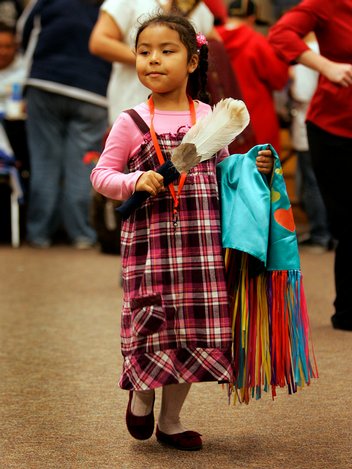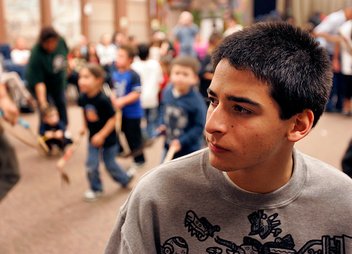Education program embraces Indians
By Maureen Magee, UNION-TRIBUNE STAFF WRITERThursday, February 25, 2010 at 12:04 a.m.
| OLD
TOWN — Every week in the outskirts of Old Town, where the Kumeyaay
Indians were colonized by the Spaniards more than 200 years ago, scores
of urban Indians meet to dance, eat and keep their heritage alive.
Some children and their families perform traditional grass dances while others beat on drums and sing native songs. The weekly meetings at the Ballard Parent Center are part of the San Diego Unified School District’s federally funded American Indian Education Program. In addition to the music and dance offerings, the program also helps the district’s Indian students with tutoring, counseling, career guidance and other services. The program is designed to support American Indian children who do not have the benefit or network of services offered to those living on a reservation, said Director Vicki Gambala, who oversees the program and its annual $80,000 budget. Of the district’s 130,000 students, 680 are listed as American Indian. A little more than 400 participate in the federal program. “We are urban Indians. Unlike reservation Indians, we don’t have big, extended families here,” Gambala said. “The biggest challenge for our children is self-esteem. Our children feel different. How many Indians attend a school? Usually one.” Chandler Hood, a senior at High Tech High, remembers being a student at Hearst Elementary School in Del Cerro and being asked if he lived in a teepee. “It was embarrassing, but also discouraging,” said Hood, who hopes to attend Harvard or Stanford next year. “It’s nice to have a place where I can come back to and practice my grass dancing and where I can get support.” The program picked up where the history books left off, usually right around the fourth-grade lessons about California missions. San Diego Unified’s American Indian students make up a fraction of the district’s population. The demographic is so small that it rarely — if ever — surfaces in discussions about test scores, dropout rates or attendance. Yet American Indians score among the lowest of any other ethnic group. “We do what we can to help our students,” Gambala said. “Sometimes we feel like the forgotten group.” |
|
Gambala and other advocates in San Diego County are encouraging American Indians to participate in the U.S. Census. They believe American Indians are vastly underrepresented, in part, because of a historical mistrust they have of the federal government. A stronger representation in the census would boost federal dollars for programs that help the small population, Gambala said.
A “Census Powwow” to promote the effort will be held from 11 a.m. to 10 p.m. March 20 at Barrio Station, 2175 Newton Ave.
Maureen Magee: maureen.magee@uniontrib.com

